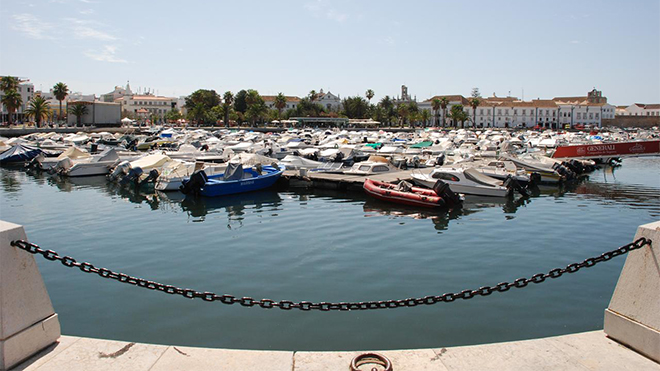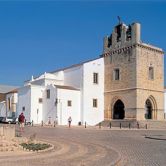Faro - Accessible Tour

Faro, the main city and capital of the Algarve is also its port of entry for all who arrive by plane since it is only around six kilometres from the international airport.
Located near the Ria Formosa and the sea, it is a city worth getting to know as you wander through the streets that King Afonso III, king of Portugal in the 13th century, captured from the Muslims.
Download the map and follow the tour
As a focus for this tour, we propose the Jardim Manuel Bívar (Manuel Bívar Gardens) (8), the main square of the city opening onto the recreational port. From here, we suggest tours in three directions to different areas of the city - Ria Formosa, Baixa de Faro and the historical Old Town. If you want to see Faro on the Tourist train, adapted for disabled people with reduced mobility, you can take the train at the Jardim Manuel Bívar, where the journey starts. The tour lasts 50 minutes. Spacious, with regular pavements, trees and esplanades (terraces), this square is a very pleasant area for going for walks or resting with the added bonus of seeing storks flying across the skies in their passage between the Ria and their nests perched on high points of the city, such as street lighting or church steeples. 
Doca de Recreio - Faro © ATA | Pedro Reis
Opposite the square, the Porto de Recreio (Recreational Port) (9), attractive because of the colourful array of boats, has an accessible area that is open to everyone to move around freely without obstacles. The port is located in the Ria Formosa, a lagoon which you can visit by boat, with tourist companies offering boat rides aimed at people with reduced mobility. Very close to the Ria, the Praia de Faro-Mar accessible by car or by boat was awarded ‘Accessible Beach’ status and is equipped with amphibious wheelchairs enabling everyone to enter the water.
Various pedestrianised streets run from the Jardim Manuel Bívar towards the city centre and to the Rua de Santo António (10) which is one of the city’s main streets. This is a busy area with many shops and restaurants. However, for some of them, it is difficult for wheelchair users to enter without help because of the steps at their entrances. Streets covered in Portuguese paving tiles are comfortable, regular and level, with only a few obstacles along terraces, which are easy to get around.
Located to the west of the Rua de Santo António, there are the Igreja de Sao Pedro and the Igreja do Carmo (Churches of St Peter and Mount Carmel). To get there, you have to walk along the Rua Vasco da Gama and the Rua do Carmo towards the Largo de São Pedro (São Pedro Square). However, the route is long and not fully accessible. So it is recommended that you take an adapted vehicle. The Igreja de São Pedro (11), which is the Mother Church of Faro, is accessible by stairs and was built on the site of an ancient hermitage built by sailors. A little further on, there is the Igreja do Carmo (12) with its impressive façade and accessible entrance. The unusual Capela dos Ossos (Chapel of Bones) is located within the church. However, it is not fully accessible because of the steps and a narrow corridor.

Arco da Vila - Faro © Câmara Municipal de Faro | Ana Abraão
From the Jardim Manuel Bívar, you can also continue the tour along the street through the Old Town (Centro Histórico), but before you leave the square, it is worth visiting the Igreja da Misericórdia (7) (Church of Mercy). It is a building with a Greek cross plan and is fully accessible. It is located very close to the Arco da Vila (6) (the Town Arch) which is the entrance to the oldest part of the city, known locally as the ‘vila adentro’ (the town within). Within this arch, there is another - the Porta Árabe (5) (the Arab Gate) which dates back to the 6th century. At that time, it was the gate entrance into the walls for anyone arriving by sea. The route continues along the Rua do Município which, because of the slope, narrow streets and irregular paving, requires greater effort and care.
Dominated by the Episcopal Palace buildings in the Largo da Sé (the Cathedral Square), there stands the Cathedral (4), built in the 13th century. To enter the Cathedral, you have to go up stairs which make it impossible for people with reduced mobility to access. Inside there are also stairs to the higher floors and narrow spaces which will affect the visit. The Museu Municipal de Faro (the Faro Municipal Museum) (2), which houses a significant archaeological treasure, is located nearby. With its accessible entrance and wide spaces on the ground floor, all visitors can enjoy a large part of this Museum which promotes activities and visits for physically disabled people with reduced mobility.

Photo: Largo da Sé - Faro © Rui Morais de Sousa
The route continues down the Rua do Repouso, which has shorter walks to the Igreja de São Francisco (São Francisco Church) (1), a church with an accessible entrance and wide spaces which enable visitors to admire the very beautiful tiled panels inside, dating back to the 18th century. At the end of this tour, admire the Arco do Repouso (3), another historical site where, according to legend, King Afonso III rested after the reconquest of Algarve. Follow the example of our king and take a break here while you plan new trips to discover Portugal.








 Explore
Explore 
 Remember and Share
Remember and Share 


